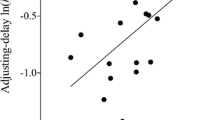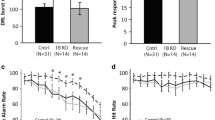Abstract
Rationale
Many studies have shown that human drug abusers are more impulsive than nonusers, but the mechanisms underlying this difference are unknown. C57BL/6J (B6) and DBA/2J (D2) mouse strains differ in sensitivity to the associative effects and in self-administration of several drugs of abuse.
Objective
To determine whether these strains exhibit differences in impulsivity that might correspond to the differences in phenotypes related to drug seeking.
Methods
We examined impulsive choice in drug-naive B6 and D2 mice using a delay discounting protocol (adjusting amount procedure, J Exp Anal Behav 67:353–366, 1997).
Results
Contrary to our initial expectations, we observed greater delay discounting (higher impulsivity) in D2 rather than in B6 mice. For both strains, discounting was enhanced by 0.80 and 1.20 mg/kg (i.p.) d-amphetamine relative to saline.
Conclusions
Data demonstrate the sensitivity of the procedure to strain differences and pharmacological manipulations. However, additional data are required to clarify the factors underlying this difference and how the delay discounting measure of impulsivity relates to phenotypic models of drug reinforcement and drug seeking.



Similar content being viewed by others
References
Ainslie G (1975) Specious reward: a behavioral theory of impulsiveness and impulse control. Psychol Bull 82:463–496
Baum WM (1974) On two types of deviation from the matching law: bias and undermatching. J Exp Anal Behav 22:231–242
Belknap JK, Crabbe JC, Young ER (1993) Voluntary consumption of ethanol in 15 inbred mouse strains. Psychopharmacology 112:503–510
Bickel WK, Marsch LA (2001) Toward a behavioral economic understanding of drug dependence: delay discounting processes. Addiction 96:73–86
Bradshaw CM, Szabadi E (1992) Choice between delayed reinforcers in a discrete-trials schedule: the effect of deprivation level. Q J Exp Psychol B 44:1–16
Cabib S, Orsini C, Le Moal M, Piazza PV (2000) Abolition and reversal of strain differences in behavioral responses to drugs of abuse after a brief experience. Science 289:463–465
Cardinal RN, Cheung THC (2005) Nucleus accumbens core lesions retard instrumental learning and performance with delayed reinforcement in the rat. BMC Neurosci 6:9–31
Cardinal RN, Robbins TW, Everitt BJ (2000) The effects of d-amphetamine, chlordiazepoxide, α-flupenthixol and behavioural manipulations on choice of signalled and unsignalled delayed reinforcement in rats. Psychopharmacology (Berl) 152:362–375
Carney JM, Landrum RW, Cheng MS, Seale TW (1991) Establishment of chronic intravenous drug self-administration in the C57BL/6J mouse. NeuroReport 2:477–480
Clark MG, Vasilevsky S, Myers TM (2003) Air and shock two-way shuttlebox avoidance in C57BL/6J and 129X1/SvJ mice. Physiol Behav 78:117–123
Crabbe JC, Phillips TJ, Buck KJ, Cunningham CL, Belknap JK (1999) Identifying genes for alcohol and drug sensitivity: recent progress and future directions. Trends Neurosci 22:173–179
Cunningham CL, Niehus DR, Malott DH, Prather LK (1992) Genetic differences in the rewarding and activating effects of morphine and ethanol. Psychopharmacology (Berl) 107:385–393
Evenden JL (1999) Varieties of impulsivity. Psychopharmacology (Berl) 146:348–361
Evenden JL, Ryan CN (1996) The pharmacology of impulsive behaviour in rats: the effects of drugs on response choice with varying delays of reinforcement. Psychopharmacology (Berl) 128:161–170
Farrar AM, Kieres AK, Hausknecht KH, Richards JB, de Wit H (2003) Effects of reinforcer magnitude on an animal model of impulsive behavior. Behav Processes 64:261–271
Forgie ML, Beyerstein BL, Alexander BK (1988) Contributions of taste factors and gender to opioid preference in C57BL and DBA mice. Psychopharmacology (Berl) 95:237–244
Grahame NJ, Cunningham CL (1995) Genetic differences in intravenous cocaine self-administration between C57BL/6J and DBA/2J mice. Psychopharmacology (Berl) 122:281–291
Green L, Myerson J (2004) A discounting framework for choice with delayed and probabilistic rewards. Psychol Bull 130:769–792
Hausknecht KA, Vakiener K, Choi S, Kieres AK, Farrar AM, Acheson A, Zhuang X, de Wit H, Richards JB (2004) Differential performance of two inbred mouse strains on three laboratory models of impulsive behavior. Program No. 671.15. 2004 Abstract Viewer/Itinerary Planner. Society for Neuroscience, Washington, DC
Ho MY, Mobini S, Chiang TJ, Bradshaw CM, Szabadi E (1999) Theory and method in the quantitative analysis of “impulsive choice” behaviour: implications for psychopharmacology. Psychopharmacology (Berl) 146:362–372
Isles AR, Humby T, Wilkinson LS (2003) Measuring impulsivity in mice using a novel operant delayed reinforcement task: effects of behavioural manipulations and d-amphetamine. Psychopharmacology (Berl) 170:376–382
Isles AR, Humby T, Walters E, Wilkinson LS (2004) Common genetic effects on variation in impulsivity and activity in mice. J Neurosci 24:6733–6640
Logue AW (1988) Research on self-control: an integrating framework. Behav Brain Sci 11:665–709
Madden GJ, Petry NM, Badger GJ, Bickel WK (1997) Impulsive and self-control choices in opioid-dependent patients and non-drug-using control participants: drug and monetary rewards. Exp Clin Psychopharmacol 5:256–262
Mazur JE (1987) An adjusting procedure for studying delayed reinforcement. In: Commons ML, Mazur JE, Nevin JA, Rachlin H (eds) Quantitative analysis of behavior, vol 5. The effect of delay and intervening events on reinforcement value. Erlbaum, Hillsdale, pp 55–73
Mazur JE (2001) Hyperbolic value addition and general models of animal choice. Psychol Rev 108:96–112
Mitchell SH (1999) Measures of impulsivity in cigarette smokers and non-smokers. Psychopharmacology (Berl) 146:455–464
Mitchell SH, Reeves JM, Li N, Phillips TJ (2006) Delay discounting predicts behavioral sensitization to ethanol in outbred WSC mice. Alcohol Clin Exp Res 30:429–437
National Research Council (1996) Guide for the care and use of laboratory animals. National Academy, Washington, DC
Perry JL, Larson EB, German JP, Madden GJ, Carroll S (2004) Impulsivity (delay discounting) as a predictor of acquisition of IV cocaine self-administration in female rats. Psychopharmacology (Berl) 178:193–201
Petry NM (2001) Delay discounting of money and alcohol in actively using alcoholics, currently abstinent alcoholics, and controls. Psychopharmacology (Berl) 154:243–250
Rachlin H, Green L (1972) Commitment, choice and self-control. J Exp Anal Behav 17:15–22
Richards JB, Mitchell SH, de Wit H, Seiden LS (1997) Determination of discount functions in rats with an adjusting-amount procedure. J Exp Anal Behav 67:353–366
Risinger F, Brown MM, Doan AM, Oakes RA (1998) Mouse strain differences in oral operant ethanol reinforcement under continuous access conditions. Alcohol Clin Exp Res 22:677–684
Semenova S, Kuzmin A, Svartau E (1995) Strain differences in the analgesic and reinforcing action of morphine in mice. Pharmacol Biochem Behav 50:17–21
Wade TR, de Wit H, Richards JB (2000) Effects of dopaminergic drugs on delayed reward as a measure of impulsive behavior in rats. Psychopharmacology (Berl) 150:90–101
Acknowledgments
The authors thank William Guethlein for programming assistance and Jerry B. Richards for an initial version of the Med-PC data collection program. Supported by National Institutes of Health grants T32-AA07468, F31-MH070219, and R01-MH067497.
Author information
Authors and Affiliations
Corresponding author
Rights and permissions
About this article
Cite this article
Helms, C.M., Reeves, J.M. & Mitchell, S.H. Impact of strain and d-amphetamine on impulsivity (delay discounting) in inbred mice. Psychopharmacology 188, 144–151 (2006). https://doi.org/10.1007/s00213-006-0478-0
Received:
Accepted:
Published:
Issue Date:
DOI: https://doi.org/10.1007/s00213-006-0478-0




